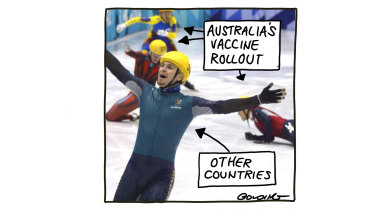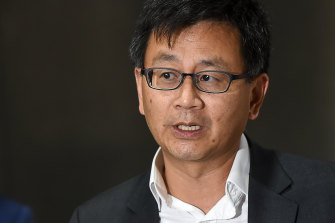Examine, a weekly science newsletter written by national science reporter Liam Mannix, is sent every Tuesday. The 10th instalment is below. You can sign up to receive it from The Age here and from The Sydney Morning Herald here.
The almost-total absence of criticism for Australia’s decision to preference Pfizer’s vaccine over AstraZeneca’s for people under 50 is remarkable.
In a single stroke, it throws Australia’s vaccine strategy into chaos. That sense of chaos will probably harm our vaccine confidence.
And the decision seems to prioritise individual risks over risks to public health.
And yet, in public comments, there has been almost universal support for this decision from vaccine experts.
Maybe that suggests that the government’s decision, made on the advice of the Australian Technical Advisory Group on Immunisation (ATAGI), was unimpeachable.
Or maybe scientists understand just how hard the decision was. The data is fluid, and whatever decision they made would have been criticised.

Credit:Illustration: Matt Golding
But science is about the clash of ideas. Scientists are encouraged to gleefully shred each other’s work, knowing that the best ideas will win.
More likely is that Australia’s scientists are anxious about criticising the government’s vaccine policy for risk of undermining public confidence in the vaccine.
They may have a point. But as a journalist, I have a reflexive dislike of senior experts muzzling themselves, if that is indeed what has happened (most scientists I have put this claim to reject it). Especially because ATAGI’s decision has such enormous public health implications.
Not only will we leave much of the population unprotected for many months – there is officially no timeline now on when we will be fully vaccinated – but we also batter the confidence of both the public and the healthcare workers meant to be giving the jab.
“We may see hesitancy around any vaccine, not just the AstraZeneca for under 50s,” says Professor Julie Leask, one of Australia’s leading experts on vaccine hesitancy at the University of Sydney.
“There will be lingering hesitancy and confusion for people.
“For these reasons, communication is more important than ever.”
ATAGI’s decision essentially amounts, as many things in life do, to a choice between two risks.
The known but very small risk of people suffering serious illness caused by AstraZeneca’s vaccine, versus the uncertain risk of a serious COVID-19 outbreak in Australia, with a possibly-large loss of life.
Did ATAGI get it right?
Based on the evidence we have so far, ATAGI estimates for every million doses of AstraZeneca given, between four and six people will develop the dangerous blood-clotting syndrome known as VIPIT. One or two of them will die, ATAGI estimates.
Would such a risk automatically rule out any similar medicine?
No. We rolled out the oral polio vaccine to every baby in Australia despite a 3 to 4 in a million risk of catching polio from the vaccine.
”I think the vaccines definitely would get approval, because it’s such a rare side effect. It’s comparable to the risk of dying in a car each year,” Professor Vlado Perkovic, dean of medicine at the University of NSW and one of Australia’s leading clinical trial experts, told me last week (he later described ATAGI’s decision as “a very sensible approach”).
How does the risk of VIPIT compare with that of COVID-19?
For every 2000 people aged between 35 and 44 who catch the virus, one will die. Perhaps one in three will have lasting symptoms.
But that is not the only reason we vaccinate people under 50.
We vaccinate young, healthy people to protect the elderly, the sick, and those who cannot have a vaccine.
“That’s the fundamental premise of why we vaccinate,” says Professor Fiona Russell, a leading vaccine expert based at the Murdoch Children’s Research Institute.
COVID-19 tends to spread through people aged 20 to 40 first, and then is spread into older age groups. The pandemic in America was disproportionately driven by people aged between 20 and 49.

ATAGI’s co-chair Professor Allen Cheng took to Twitter to explain why the committee put the Pfizer vaccine ahead of AstraZeneca for under-50s.Credit:Justin McManus
Of Australia’s COVID-19 cases, 19,623 have been in people younger than 50, compared with 9594 over 50.
“When ATAGI looked at the data, they are looking at an individual. There is much more spread by people between the age of 20 and 40 – mainly because they are working more often and have families. They were not taken into account in those calculations,” says Australian National University microbiologist Professor Peter Collignon.
What are the odds Australia has another major COVID-19 outbreak in the next year?
It’s hard to tell, but the number is not zero. If it occurs, we can expect people under 50 to drive it. Most of the mortality risk should be mitigated by vaccinating the elderly. But, by not vaccinating the young, we leave the pandemic’s engine room unprotected.
ATAGI note that risk, but argue we could just roll out AstraZeneca if there is another outbreak.
Maybe that’s true – but, given the government has struggled to roll out the vaccine with months of planning, rapid mass-vaccination during an outbreak seems a stretch. Not to mention the vaccine hesitancy rate would be sky-high if we now told under-50s that we were going to give them AstraZeneca after all.
Professor Allen Cheng, ATAGI’s co-chair, told The Age and The Sydney Morning Herald that the committee was swayed when its lay members found themselves struggling to make sense of the risks and benefits.
“It’s a very disappointing thing to hear,” says Professor Fiona Russell. “If the consumers on ATAGI could not understand the technical jargon, there are ways this can be explained extremely well and thoroughly, but you need professional expertise to do that. That’s a major flaw in my opinion.”
ATAGI’s decision would be much more defendable if there was an alternative vaccine for under ’50s. But we don’t have one.
That means the decision really amounts to a gamble – on Australia not having a major outbreak this year.
Would you make the same bet?
Examine newsletter
Science and health explained and analysed with a rigorous focus on the evidence. Examine is a weekly newsletter by science reporter Liam Mannix. Sign up to receive it every Tuesday.
Liam is The Age and The Sydney Morning Herald's science reporter
Most Viewed in National
https://news.google.com/__i/rss/rd/articles/CBMiXmh0dHBzOi8vd3d3LnNtaC5jb20uYXUvbmF0aW9uYWwvZGlkLWF1c3RyYWxpYS1nZXQtaXQtcmlnaHQtb24tYXN0cmF6ZW5lY2EtMjAyMTA0MTMtcDU3aXRzLmh0bWzSAV5odHRwczovL2FtcC5zbWguY29tLmF1L25hdGlvbmFsL2RpZC1hdXN0cmFsaWEtZ2V0LWl0LXJpZ2h0LW9uLWFzdHJhemVuZWNhLTIwMjEwNDEzLXA1N2l0cy5odG1s?oc=5
2021-04-13 19:00:00Z
52781502127079
Bagikan Berita Ini














0 Response to "Did Australia get it right on AstraZeneca? - Sydney Morning Herald"
Post a Comment